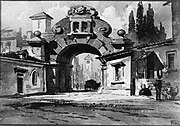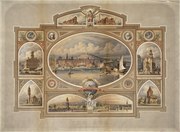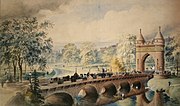Theodore Otto Langerfeldt
Theodore Otto Langerfeldt | |
|---|---|
| Born | March 2, 1841 |
| Died | September 7, 1906 |
| Nationality | German-American |
| Education | Polytechnische Schule |
| Known for | |
Theodore Otto Langerfeldt (March 2, 1841 – September 7, 1906) was a German-American architectural renderer, watercolorist, and painter.
Biography[edit]

Langerfeldt was born March 2, 1841, in Bückeburg, then capital of the German principality of Schaumburg-Lippe.[1] He studied architecture at Polytechnische Schule in Hanover. Circa 1863 Langerfeldt moved to England, where he studied and worked as a painter for five years. In 1868 he moved to the United States, settling in Boston, Massachusetts.[2] He was first noted in the Boston directories in 1870 as an architect with an office in the Studio Building. From 1875 until his death he is instead noted as a watercolor artist.[3]
Langerfeldt was best known for his architectural subjects, and was often employed by architects of Boston and New York to prepare watercolor perspective renderings for competition entries or exhibitions.[4] These architects included Charles B. Atwood, George A. Clough,[5] George Keller,[6] McKim, Mead & White,[7] Peabody & Stearns,[8] William G. Preston[5] and Frederick W. Stickney.[5] Presenting a watercolor by Langerfeldt with a competition design was considered a great advantage.[4] In 1876, at the Centennial Exposition in Philadelphia, one of his drawings received an award.[2]
He was one of the first artists to provide professional rendering services to architects, preceding a later generation which included E. Eldon Deane, David A. Gregg, and Hughson Hawley, among others. He largely withdrew from work for architects in the 1890s, as his health worsened.[4] Following an illness of ten years, Langerfeldt died September 7, 1906, in Boston.[1]
Langerfeldt signed his drawings "T. O. L." In addition to his architectural work, Langerfeldt also painted landscapes, and had a solo show at the Boston Art Club in 1874.[2] Two of his landscapes are in the collection of the Museum of Fine Arts, Boston.
Gallery of works[edit]
-
"Landscape with a Baroque Gateway" watercolor.
-
"Winter Landscape" watercolor.
-
Outdoor rural landscape watercolor in Portsmouth, New Hampshire.
-
Park River Bridge and Soldiers and Sailors Memorial Arch in Hartford, Connecticut, George Keller, architect, Langerfeldt, artist.
References[edit]
- ^ a b New England Historical and Genealogical Register, vol. 7 (Boston: New England Historic Genealogical Society, 1907)
- ^ a b c Clement, Clara Erskine; Hutton, Laurence. Artists of the Nineteenth Century and Their Works: A Handbook Containing Two Thousand and Fifty Biographical Sketches. Vol. I. Boston and New York: Houghton, Mifflin and Company. pp. 38–39.
- ^ Boston directories
- ^ a b c "Death of T. O. Langerfeldt," American Architect and Building News 90, no. 1603 (September 15, 1906): 82.
- ^ a b c Sturgis, R. Clipston (1890). Catalogue of the First Annual Exhibition of the Boston Architectural Club. Boston Architectural Club.
- ^ Stagis, Julie (September 16, 2011). "Soldiers And Sailors Arch To Be Rededicated". The Hartford Courant. Archived from the original on 12 May 2021. Retrieved 13 April 2012.
- ^ "Exhibition of the Boston Public Library Plans," American Architect and Building News 23, no. 643 (April 21, 1888): 182.
- ^ Holden, Wheaton A. (May 1973). "The Peabody Touch: Peabody and Stearns of Boston, 1870-1917". Journal of the Society of Architectural Historians. 32 (2). University of California Press: 114–131. doi:10.2307/988826. JSTOR 988826 – via JSTOR.






